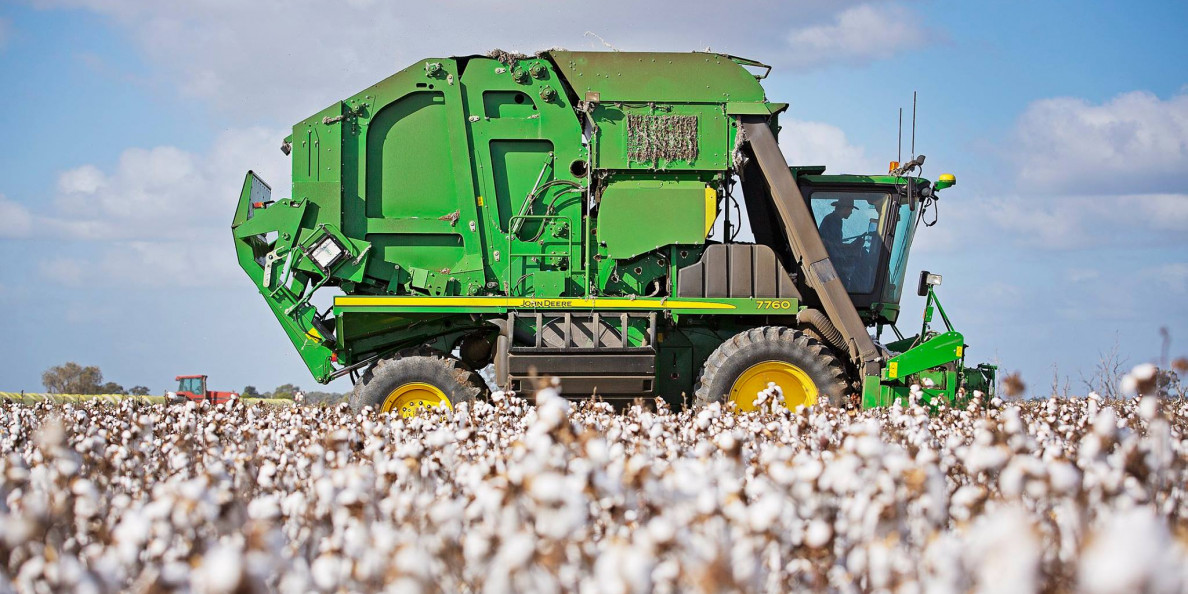By William Thornton | wthornton@al.com
When Nick McMichen talks about the fears he harbored for Alabama’s cotton crops a decade ago, he can sum them up in two words.
“Yoga pants.”
He almost spits the words out, but he does so in a $10 million cotton gin that he and his partners opened earlier this year outside Centre in Cherokee County. The gin, as well as a growing demand nationally, is a sign that times are improving for Alabama’s oldest cash crop.
Why yoga pants? Because of the popularity of the style, even for those who don’t set foot inside a studio. Just a few years ago, imports of elastic knit pants surpassed blue jeans, according to the U.S. Census Bureau. That statistic is only part of a larger shift toward synthetic fabrics that has been gaining steam for the past two decades.
But cotton rules the cash crops, one indicator of an improving economy. Dale Monks, an Auburn University professor and director of research operations and outlying units with the school’s agricultural faculty, explains why.
“The more prosperous a country becomes, the more they tend to eat meat, and the more they wear cotton,” Monks said.
If you think about it, cotton has certain natural characteristics as a fabric that make it associated with disposable income, he said. Man-made fibers wear longer, and don’t “breathe” as well as natural fibers.
And artificial fibers have historically been tied to the price of crude oil, used in their production. Ten years ago, America was dealing with the effects of the Great Recession. At the same time, the prices of corn, soybeans and winter wheat rose significantly higher than cotton, making those crops more attractive than the white bolls. That led to a significant drop in Alabama’s acreage tied to cotton.

Cotton, once king in Alabama, still rules on these family farms
As Alabama celebrates 200 years of statehood, cotton, once the state's economic engine, is still going strong.
That quickly changed though, once demand returned. And along with a better economy, cotton has become more attractive. The fabric can be made more water resistant, with brands such as Under Armour’s Charged Cotton, and Nike’s Dri-Fit Cotton. And it’s proving popular with a more environmentally conscious consumer culture, concerned about sustainability.
“That matters to this generation,” McMichen said.
In addition to Cherokee County’s new gin, another one sprang up last year in Athens. The Associated Growers Cooperative built a $7.4 million gin in Limestone County, the first major one built in 60 years. It replaced an older gin that was capable of ginning about 20 bales an hour. The new one can produce 60 an hour. From the end of October through Dec. 30 last year, the new gin produced 42,440 bales of cotton, with two shifts of seven workers going in 12 hour shifts.
“I still ride by and pinch myself when I see it,” Billy Stickler, the gin manager said. “There were times when I didn’t think we’d see a new gin, but the infrastructure is coming back for cotton.”
Traditional cotton products are also proving popular. In Lawrence County, Red Land Cotton markets sheets, towels and baby bedding made from cotton grown on a family farm. Mark Yeager and his daughter Anna Brakefield created the business in 2016.
And of course, when you’re talk cotton, you’re also talking blue jeans. Wrangler markets its Rooted Collection with special Alabama slim fit jeans, featuring an Alabama patch and a button with the state’s outline embossed into it.
The cotton comes from Limestone County, from the Newby family’s farm outside Athens. The Newbys – Jimmy, James, John, Jerry and Elizabeth – are the latest of seven generations to grow cotton on their land.
Two years ago, Wrangler began its Science and Conservation Program to advocate for land stewardship and soil health practices. Part of that was partnerships with family farms in several states.
After two years of development, the Alabama jeans are ready to order. Jerry Newby, one of the family members, just got some samples in June.
The Newby’s farm land stretching from Limestone County into Tennessee along Interstate 65. In addition to cotton, the family also grows corn, wheat, beans and raises cattle.
For Jerry, the jeans are a traditional product that showcases his family’s heritage.
“The American farmer is the best steward of the land,” he said. “He’s on the cutting edge of technology now.”


